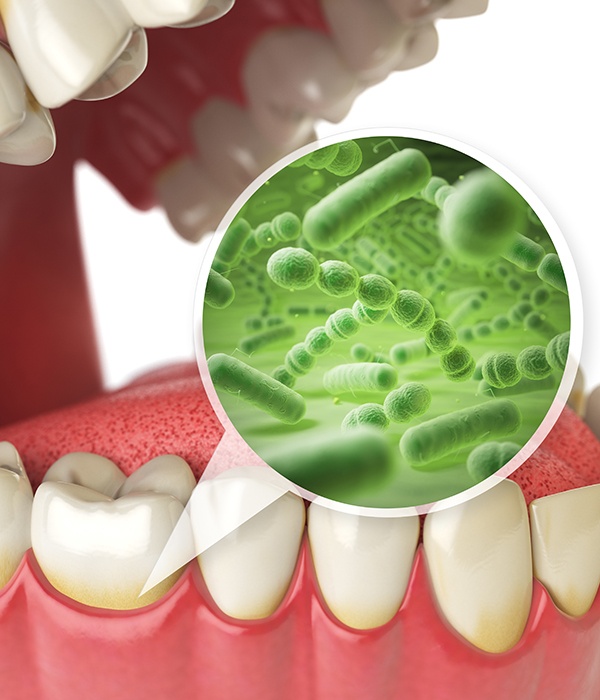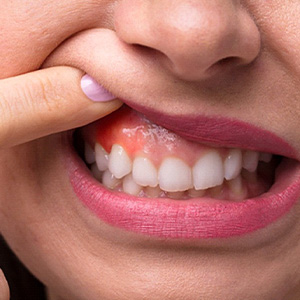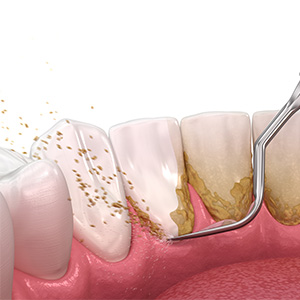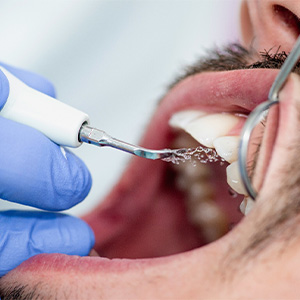
Gum Disease Treatment – Colorado Springs, CO
Keeping Your Smile Safe from Infection

According to the Centers for Disease Control and Prevention (CDC), an estimated 47.2 percent of Americans over the age of 30 suffer from periodontitis, or gum disease. That means that 64.7 million adults in the U.S. are at risk for complications associated with this condition, a growing epidemic that is highly preventable with good home hygiene and routine visits to the dentist. Knowing the symptoms of gum disease is the first step toward seeking effective treatment from board-certified specialists and protecting yourself from dangerous oral pathogens present in cases of advanced periodontitis. Learn more about gum disease and periodontal treatment in Colorado Springs on this page.
Why Choose Rocky Mountain Periodontal Specialists for Gum Disease Treatment?
- 45 Combined Years of Periodontal Experience
- A Warm, Welcoming Office That Patients Trust
- Wide Variety of Periodontal Treatment Options
What is Gum Disease?

Gum disease is an infection that occurs in the gum tissue from bacteria found in plaque and tartar buildup. At first, the early stages of the infection may not seem concerning, but if it’s left untreated, it will destroy the supporting structures of your teeth. The bacteria can also enter your bloodstream, increasing your risk of several health concerns, like cardiovascular disease.
Although gum disease is preventable, more than 80% of American adults have some form of it. Not to mention, 30% of the population is genetically predisposed for it. Besides genetics and poor oral hygiene habits, other risk factors for gum disease include smoking, age, poor oral hygiene, certain medications, and bad eating habits.
Symptoms of Gum Disease

The only definitive way to diagnose gum disease is to visit Rocky Mountain Periodontal Specialists in Colorado Springs. During this appointment, our periodontists will carefully assess your teeth and gums for any signs of periodontal disease. The most common symptoms of gum disease include:
- Redness and swelling along the gum line
- Gum recession as the gingival tissue pulls away from the teeth
- Teeth that appear longer as roots are exposed
- Pain and/or bleeding when brushing and/or flossing
- Teeth that feel loose
- Persistent bad breath (halitosis)
In addition, if you notice any tenderness or unusual sensitivity to heat or cold when eating or drinking, it is possible that your gums are infected. A consultation with our board-certified experts will determine the underlying cause of your discomfort and, if an infection is present, we will develop a treatment plan specifically designed with your improved oral health in mind.
How Do We Treat Gum Disease?

Our team employs non-surgical techniques and treatments to help stop and reverse gum disease, like scaling and root plaining. You can learn more about our treatment options below to get a better understanding of what’s involved in the process.
Scaling & Root Planing

In many cases, gum disease can be treated with a two-part deep cleaning that consists of scaling and root planing. Scaling involves getting rid of plaque and tartar around and below the gumline in order to reduce the level of harmful bacteria in the mouth. Then, root planing is performed to smooth out the surfaces of the tooth roots; this step encourages the gums to reattach to the teeth.
When is Scaling & Root Planing Necessary?

If caught early enough, gum disease treatment doesn’t require surgery or invasive procedures. In the beginning stages of gum disease, plaque and tartar build up and inflame and infect the gums. This can cause small pockets to form below the teeth that become home to bacteria. However, we can catch this issue before it causes permanent bone and tissue damage. If the structures beneath your gumline are still unaffected, we will usually recommend scaling and root planing. This is also known as a deep cleaning, where we are able to remove all the hardened tartar and get your gums back to their full health.
The Scaling & Root Planing Process

Scaling and root planing is a two-step process that is used to treat gum disease. Usually, patients will be recommended this treatment every three to six months, depending on how severe their gum disease is. However, in some cases, a single scaling and root planing treatment combined with good oral healthcare is enough to prevent gum disease from returning.
Scaling

Before beginning, one of our expert periodontists in Colorado Springs will ensure that you’re numb and comfortable using local anesthesia. They also offer sedation if you’d like to experience a greater sense of calm. Once you’re completely relaxed, they will carefully scale your smile, removing tough plaque and tartar from above, on, and beneath the gumline. This step addresses the current problem that affects your grin, cleaning away infectious material that could cause damage.
Root Planing

Once your smile has been cleaned and disinfected, we will set up your oral health for success in the future with the root planing process. This involves reaching under your gumline to access the tooth roots. We will carefully smooth the roots out, making it more difficult for bacteria, plaque, and food debris to collect underneath the gums. This will lower your risk of inflammation and infection down the road. Lastly, we will usually prescribe you with an antibiotic to reduce bacteria associated with gum disease.
Aftercare Tips for Scaling & Root Planing

Following your treatment, our team will provide you with detailed aftercare instructions to help you make a smooth and comfortable recovery. Some of these instructions include:
- Avoid eating for at least two hours following your treatment, until the local anesthesia has worn off.
- Rinse with salt water every few hours, and after you eat, to clean your mouth and alleviate inflammation.
- Brush and floss your teeth as you normally would, being sure to be gentle near the treated or sore area.
- Call our office if you have any questions or concerns about your symptoms.
The Importance of Treating Gum Disease

Untreated gum disease can lead to a variety of serious complications, including loose or shifting teeth, exposed tooth roots, and even the loss of teeth altogether. When the supporting structures within the jaw begin to deteriorate, the face can begin to take on a sunken appearance and the pain may become debilitating. In addition to these oral health concerns, patients with periodontal disease also face an increased risk of heart disease, heart attack, high blood pressure, pulmonary hypertension, stroke, dementia, and certain types of cancer.
Fortunately, scaling and root planing is an effective method of treating gum disease before it worsens. If you or someone in your family is experiencing any of the common symptoms of periodontal disease, please do not hesitate to contact us to schedule your visit to Rocky Mountain Periodontal Specialists today. Our team genuinely looks forward to providing you with the care you need to prevent and treat periodontal disease to improve your overall health.